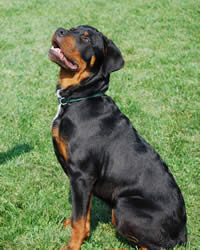Rottweiler Breed Information
 |
| ||||||||||||||||||||||||||||||||||||||||||||||||||||||||||||||||||||||||||||||||
Just The Facts
| Do you own this Dog breed?Please tell us about it in the form at the bottom of this page. Need a good Puppy Name?Visit our Rottweiler dog names page. |
General Description
The Rottweiler is a confident and imposing dog. They have a dominant and stubborn nature, they are very loyal and they make excellent guard dogs. Due to their nature, they require consistent training and socialization. These dogs can be overly protective of family members and may revert to herding instincts around children.
Origin and History
The Rottie, as they are often known, is descended from Roman drover dogs, and they were bred in Germany when many of the Roman troops settled in the area.
The dogs served as guard animals until the mid-19th century, when dog carting was replaced by the railroad.
The popularity of the breed fell into decline until two clubs designed to promote the breed merged. The dogs began to be bred as police dogs and have been competing in the AKC since the 1930s
Temperament
The Rottweiler is a bold, confident breed. They can be headstrong and stubborn and often take a domineering approach. These dogs can be overly protective and are wary of strangers. They are very loyal dogs, but require consistent training.
Rottweiler Dog Breed Care
Living Environment – Rotties need a large and secure area for both exercise and play. Space is important in large part due to the size of the dogs. They are protective around strangers, but can thrive around children that are brought up with them. These dogs also do well with older children who know how to behave with them. They must be exposed early to other pets to prevent aggression.
Grooming – This dog breed requires little in the area of grooming. Weekly brushing can keep the coat in good condition. Brushing may be needed more frequently when the dog is shedding, and the breed is considered a medium shedder. This should be considered for households that contain members with allergies.
Diet & Exercise – The diet for these large dogs should be portioned in order to prevent overeating. They require at least two hours of exercise daily. A large yard for play is recommended, and these dogs also enjoy long walks.
Health – Like other large dog breeds, these dogs have a shorter life expectancy than many breeds. There are many health problems
associated with the breed, including eye and heart problems, OCD, cancer, thyroid problems, seizures,
and allergies. Parents should have heart clearance as well as OFA and CERF certificates.
Trainability
The Rottweiler is a very intelligent dog that can excel at training if given the chance. Obedience training is mandatory with these dogs, and owners must show dominance. While the dogs can be stubborn, they are able to perform in many trials and sports.
Do you own this dog breed?
Please tell us about your experience with a particular dog breed, and upload a picture if you have one!
What Other Visitors Have Said
Click below to see contributions from other visitors to this page...
Pixie - My Rottweiler 




Pixie, my Rottweiler, is always right their. If she hears a loud voice she is sure to belch a thunderous bark back.
My children ride her like a donkey. …
Rottweiler are US! 




We have been proud owners of not one, but three Rottweiler's. The first was Skeeter who we thought could never be replaced. He was beautiful and weighed …
Return from Rottweiler Dog Breed back to List of Dogs Breeds page